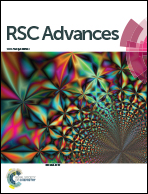Manganese ferrite nanoparticle catalyzed tandem and green synthesis of spirooxindoles†
Abstract
An environmentally benign and efficient method for the synthesis of spirooxindoles has been developed via a one-pot and three-component reaction of isatins, malononitrile, and anilinolactones in the presence of a catalytic amount of manganese ferrite nanoparticles in PEG-400, as a nontoxic, green, and reusable solvent. The significant advantages of this protocol are; the use of a magnetically recoverable and reusable catalyst, high to excellent product yields, operational simplicity and the use of PEG-400 as an environmentally-friendly solvent.


 Please wait while we load your content...
Please wait while we load your content...